Overview
The article titled "Navigate Social Security Assistance: Your Step-by-Step Guide" is designed to support you in your journey towards obtaining Social Security benefits. We understand that navigating the complexities of Disability Insurance (SSDI) and Supplemental Income (SSI) can be overwhelming. This guide offers a comprehensive framework to help you through the processes and requirements involved.
In this guide, we will outline the eligibility criteria, necessary documentation, and step-by-step application procedures. It's common to feel uncertain about what is needed, but thorough preparation can significantly enhance your chances of a successful application. Remember, you're not alone in this journey; we're here to help you every step of the way.
By following our guide, you can approach your application with confidence and clarity. Take your time to gather the required information, and don't hesitate to reach out for assistance if needed. Your efforts today can lead to the support you deserve tomorrow.
Introduction
Navigating the maze of Social Security assistance can feel overwhelming for many individuals seeking support during challenging times. We understand that programs like Disability Insurance (SSDI) and Supplemental Income (SSI) offer crucial financial aid, yet the complexities of eligibility and application processes can leave you feeling lost.
It's common to feel uncertain about the requirements and documentation needed to secure benefits. How can you effectively maneuver through these challenges to ensure you receive the assistance you deserve?
This guide offers a comprehensive, step-by-step approach to demystifying Social Security assistance, empowering you to take control of your application and secure your financial future.
Remember, you're not alone in this journey; we're here to help.
Understand the Basics of Social Security Assistance
Public assistance encompasses two key programs: Disability Insurance (SSDI) and Supplemental Income (SSI). SSDI is specifically designed for individuals who have contributed to the social insurance system through their work history but are currently unable to work due to a disability. On the other hand, SSI provides financial support to those with limited income and resources, regardless of their employment background. Understanding these differences is vital, as they directly impact eligibility and the application process.
At Turnout, we simplify access to these essential government benefits by offering tools and services that help consumers navigate the complexities of SSD claims. The Administration of Public Services (SSA) defines 'disability' as a condition that significantly hinders one or more major life activities, encompassing both physical and mental health concerns. As of December 2023, over 8.7 million disabled beneficiaries received disability benefits, totaling nearly $12.7 billion. The average monthly benefit for disabled workers stands at $1,537.13, underscoring the financial support available to this community. Furthermore, nearly 7.5 million SSI recipients will see their payments adjusted by 2.5% due to a cost-of-living adjustment (COLA) starting in January 2025, which is crucial for individuals receiving disability benefits as it helps them manage rising living costs due to inflation.
Eligibility for SSDI requires applicants to have a sufficient work history and to have contributed to taxes, while SSI eligibility is based on income and resource thresholds. In 2025, the full federal SSI benefit rate is approximately $967, which is about three-quarters of the poverty line for a single individual. It’s also essential to report any significant life changes, such as marriage or divorce, as these can influence eligibility. Understanding these criteria is key to navigating the application process effectively.
At Turnout, we employ trained nonlawyer advocates to assist clients with SSD claims, ensuring that individuals receive the guidance they need without the complexities of legal representation. Please remember that Turnout is not a law firm and does not provide legal advice. We're here to help you through this journey, and you are not alone.
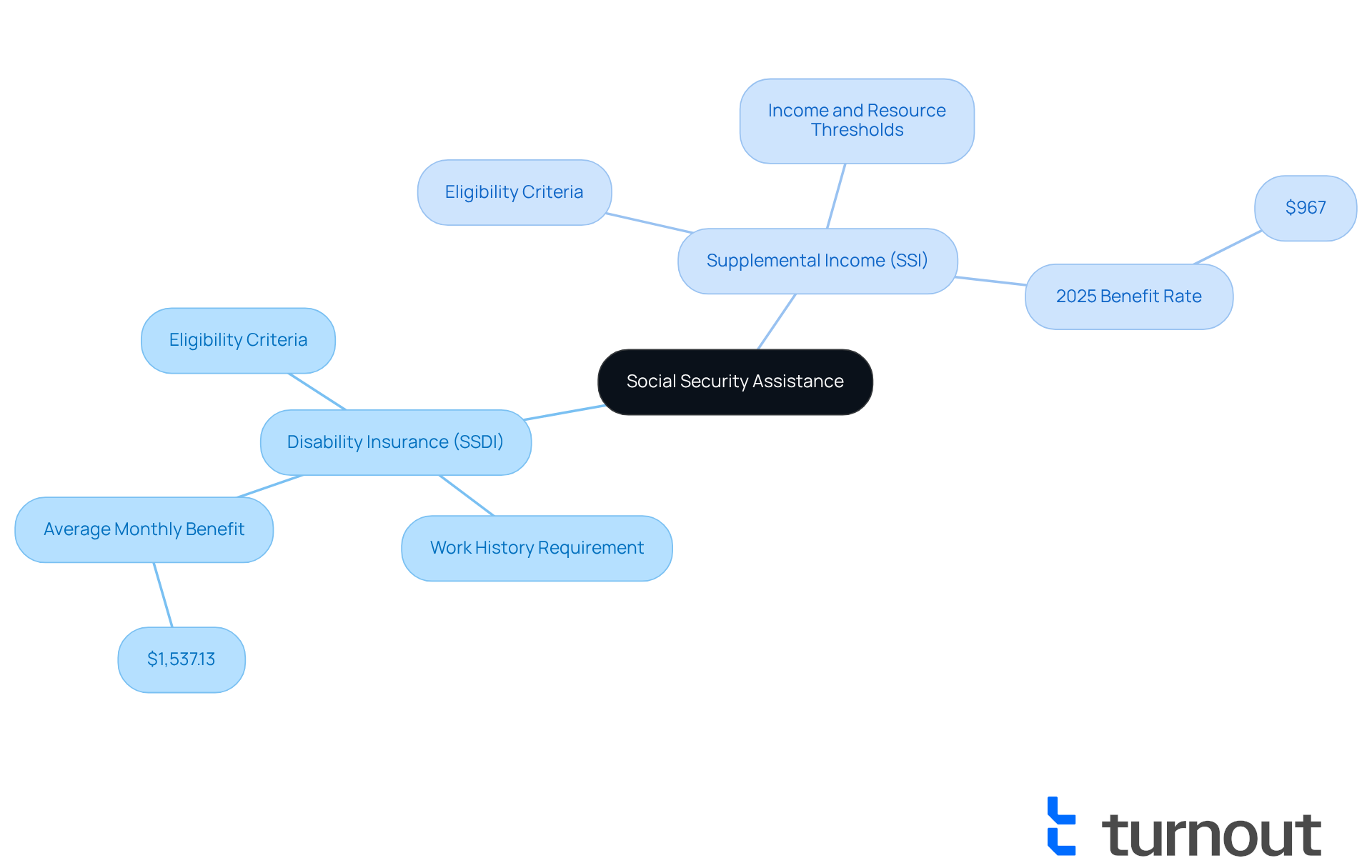
Determine Your Eligibility for Benefits
Determining your eligibility for social security assistance benefits can feel overwhelming, but we're here to help. Let’s explore the criteria together:
-
For SSDI: To qualify for Social Security Disability Insurance (SSDI), you need to have worked a specific number of years and contributed to the system. Generally, this means you need 40 work credits, with at least 20 earned in the last decade. It’s essential to have a qualifying disability that prevents you from engaging in substantial gainful activity. As of 2024, over 8.3 million adults are receiving SSDI benefits, underscoring the importance of understanding these requirements.
-
For SSI: Supplemental Security Income (SSI) has its own criteria. You must be aged 65 or older, blind, or disabled, and have limited income and resources. The Social Security Administration (SSA) sets specific income limits that vary by state. For 2025, the maximum monthly SSI payment is $967 for individuals and $1,450 for couples, with resource limits of $2,000 for individuals and $3,000 for couples.
-
Special Considerations: If you are a veteran or have specific medical conditions, there may be additional criteria that apply to you. For instance, veterans might qualify for government assistance benefits due to service-related disabilities. It’s always a good idea to refer to the SSA's official guidelines or consult with a knowledgeable advocate who can clarify your unique situation. Disability advocates emphasize the importance of understanding work credit requirements, as these credits are crucial for accessing benefits and can significantly impact your financial stability.
We understand that navigating these options can be challenging, but remember, you are not alone in this journey. Take the time to explore your eligibility and reach out for support when needed.
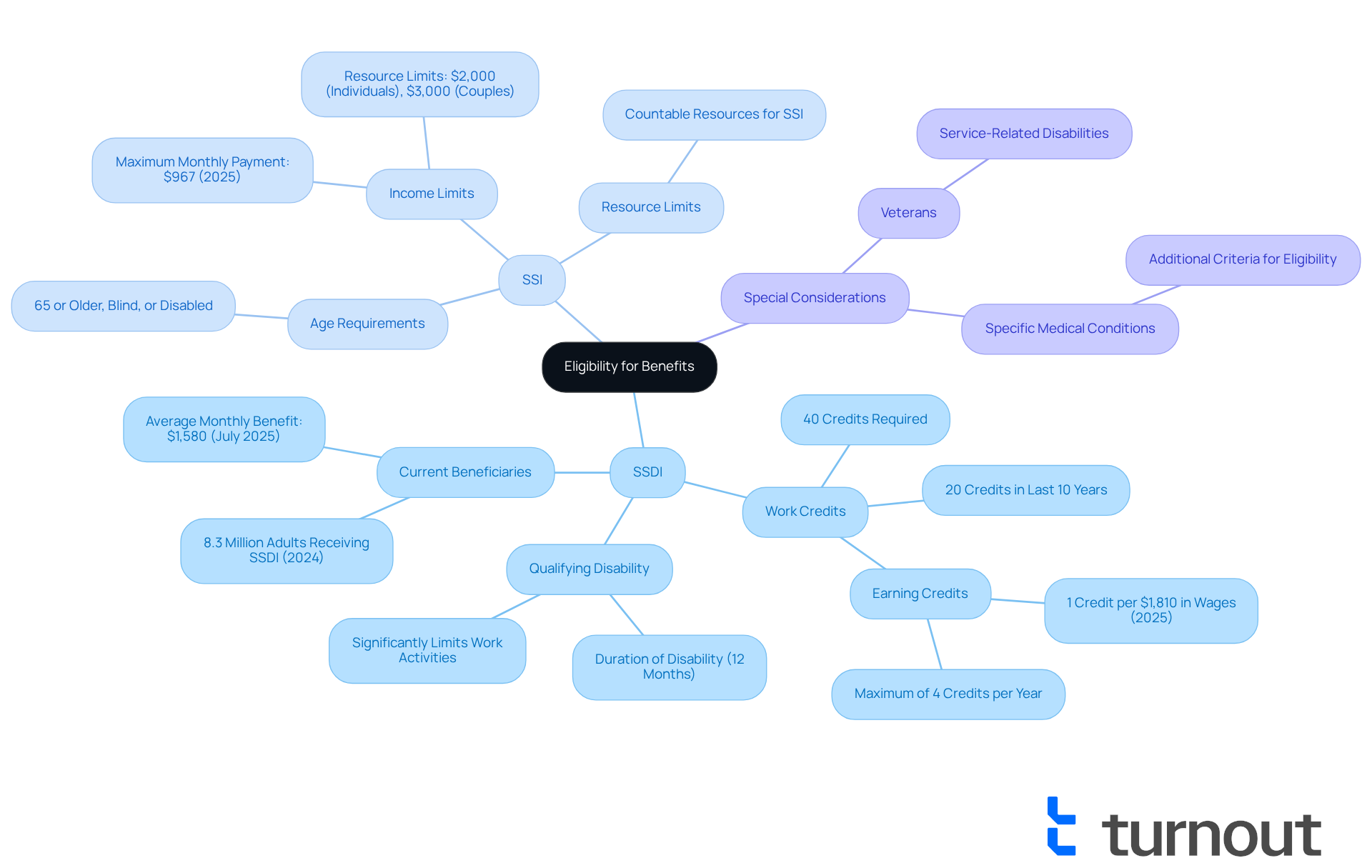
Gather Necessary Documentation for Your Application
Before applying for Social Security benefits, we understand that gathering the necessary documents can feel overwhelming. To help you through this process, here’s a list of essential items to collect:
-
Personal Identification: Please include your identification number, birth certificate, and proof of citizenship or lawful residency.
-
Medical Records: It’s crucial to obtain detailed medical documentation from your healthcare providers that clearly outlines your disability. This should encompass diagnoses, treatment history, and relevant test results. Strong medical evidence is essential, as the Social Benefits Administration (SSA) requires clear proof that your condition hinders you from working. Remember, incomplete or missing medical documentation is a common cause for denials; approximately 65-70% of initial SSDI submissions face rejection due to insufficient information.
-
Work History: Compile a comprehensive record of your employment history, detailing names of employers, dates of employment, and job descriptions. This information is particularly important for SSDI applicants, as the SSA evaluates claims based on work history and the impact of your disability on your ability to perform job duties.
-
Financial Information: If you are applying for social security assistance or Supplemental Security Income (SSI), please provide details about your income, assets, and any other financial resources. This includes bank statements, pay stubs, and tax returns, which help establish your financial need.
-
Additional Forms: Complete the necessary enrollment forms, such as the SSA-16 for SSDI or the SSI enrollment document. Ensure that all information is accurate and up-to-date to avoid delays in processing.
Gathering complete and accurate documentation significantly enhances your chances of a successful application. Advocates emphasize that thorough medical records can make a substantial difference in the outcome of disability claims, as they provide the SSA with the necessary evidence to support your case. Remember, you are not alone in this journey; we’re here to help you every step of the way.
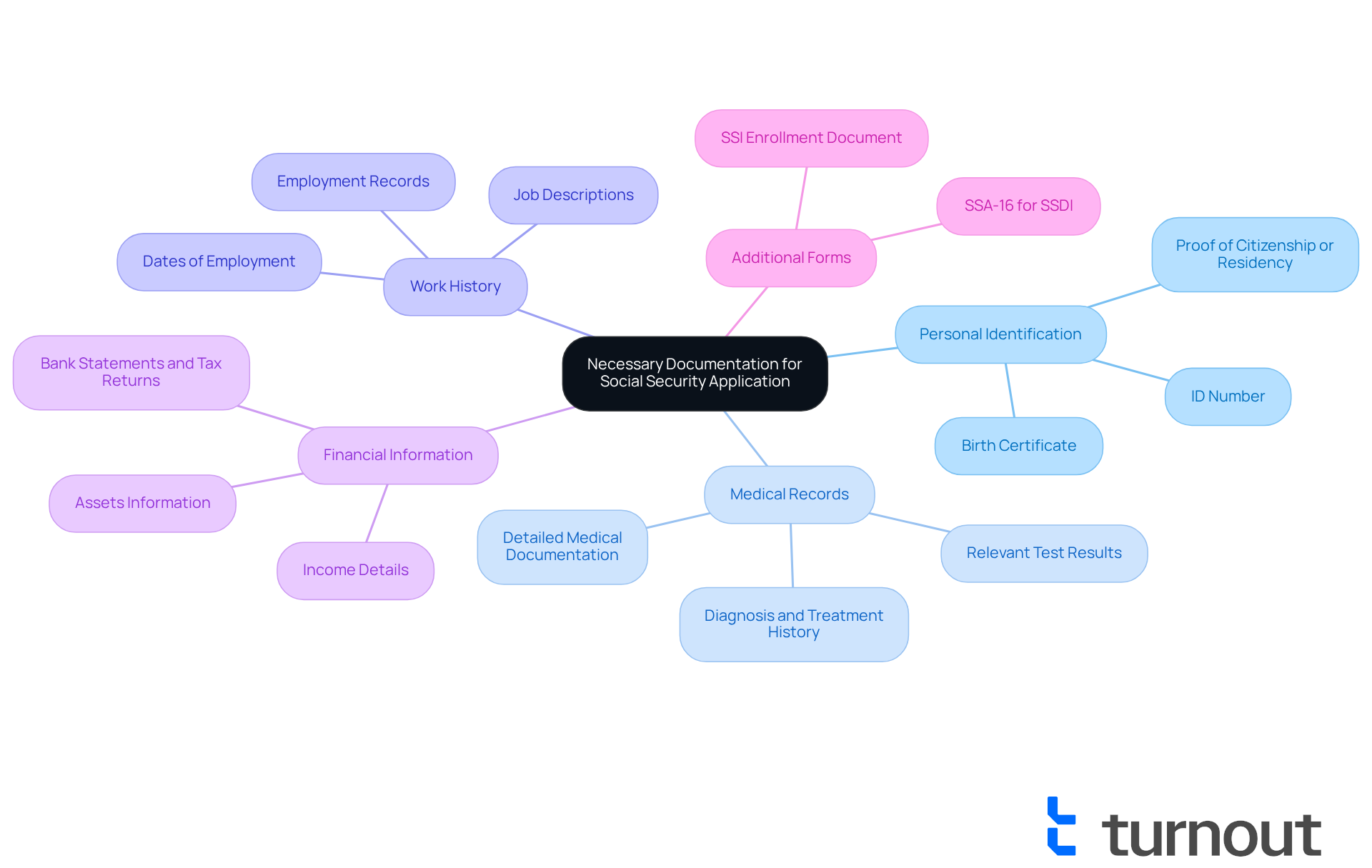
Apply for Social Security Benefits: Step-by-Step Process
Applying for social security assistance can feel overwhelming, but we're here to guide you through each step with care and understanding. Follow these essential steps to make the process smoother:
-
Choose Your Application Method: You have options when applying—online through the SSA website, by phone, or in person at your local Social Security office. Many find online submissions to be the most convenient and quickest method.
-
Complete the Application: Take your time to fill out the required forms accurately. For SSDI, you'll need Form SSA-16; for SSI, use the SSI enrollment form. Ensure all sections are completed to avoid delays, as unfinished submissions can significantly extend processing times.
-
Submit Your Documentation: It's crucial to attach all necessary documentation as outlined in the submission guidelines. If applying online, you may need to upload documents; if by mail, remember to send copies, not originals, to protect your important documents.
-
Review and Confirm: Before you submit, take a moment to check your documents for accuracy. Confirm that all required fields are filled and that your documentation is complete. This step is vital, as errors can lead to additional requests for information and further delays.
-
Submit Your Request: Once everything is in order, go ahead and submit your request. If applying online, follow the prompts to finalize your submission. If by mail, ensure you send it to the correct SSA address with the right postage and tracking.
-
Monitor Your Submission: After submitting, you can track the status of your request online or by contacting the SSA. Keep a record of your confirmation number for reference. As of 2025, the average processing time for SSDI requests is about 7 to 7.5 months, so staying updated on your request is essential.
Real-life examples show that applicants who provide comprehensive and accurate online forms often experience more seamless processing. Experts recommend applying early, as the SSA allows individuals to apply up to four months before they become eligible. This proactive approach can alleviate some of the financial strain caused by lengthy wait times for social security assistance, which have increased by 86% since 2019. Remember, the SSA will notify you of your approval or denial status via a mailed decision letter. Patience and diligence are key throughout this process—you are not alone in this journey.
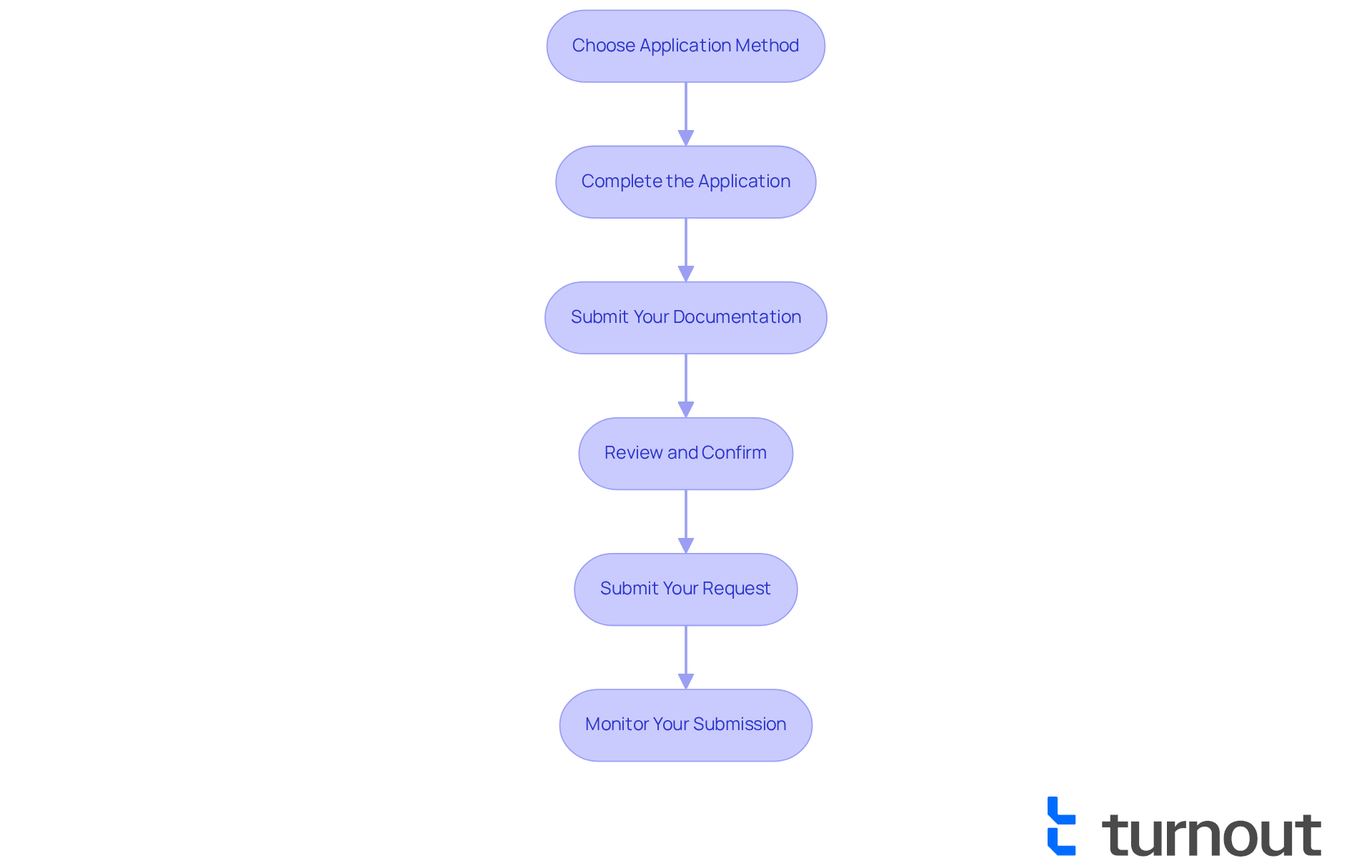
Troubleshoot Common Application Issues
Here are some common issues you may encounter as an applicant, along with ways to troubleshoot them. Remember, Turnout is here to assist you through this journey:
-
Incomplete Submissions: We understand that filling out forms can be overwhelming. It's crucial to ensure all sections are completed. Missing information can lead to significant delays, as the Social Security Administration (SSA) often requires complete submissions for efficient processing. Did you know that approximately 62% of initial SSDI submissions are denied due to incomplete information? Double-check your submission before sending it to avoid unnecessary setbacks. Our trained non-legal advocates at Turnout can help you review your submission to ensure everything is complete.
-
Documentation Problems: If your documentation is not accepted, it’s important to verify that you have provided the correct and complete documents. This includes ensuring your medical records are current and comprehensive. If needed, don’t hesitate to request additional documentation from your healthcare providers or employers to support your claim adequately. Turnout is here to assist you in collecting the essential documentation needed for social security assistance to enhance your submission.
-
Long Processing Times: If your request is taking longer than expected, it’s common to feel anxious. Please reach out to the SSA for an update. As of November 2023, the average wait time for a decision on new submissions is around 225 days, reflecting an increase of 86% since 2019. Be prepared to provide your submission confirmation number when checking your status. Turnout can help you monitor your submission and understand the process of social security assistance better.
-
Denial of Benefits: If your request is denied, take a moment to examine the denial letter thoroughly. It will outline the specific reasons for denial, such as insufficient medical evidence or failure to meet non-disability requirements. You can appeal the decision by following the instructions in the letter. Many applicants find success at the hearing level, where approval rates are significantly higher—54% of applicants win benefits during appeals. Our advocates at Turnout can effectively guide you through the appeals process for social security assistance.
-
Technical Issues: If you are applying online and encounter technical difficulties, it’s understandable to feel frustrated. Ensure your internet connection is stable and consider trying a different browser. If issues persist, please contact SSA technical support for assistance. Additionally, we encourage you to monitor your claim status through SSA's online portal, as this proactive measure can help you manage your process more effectively. Turnout can provide guidance on utilizing these online tools to stay informed about your application.
Please remember that Turnout is not a law firm, and our services do not constitute legal advice. We utilize trained nonlawyer advocates to assist you in navigating these processes. You are not alone in this journey, and we are here to help.
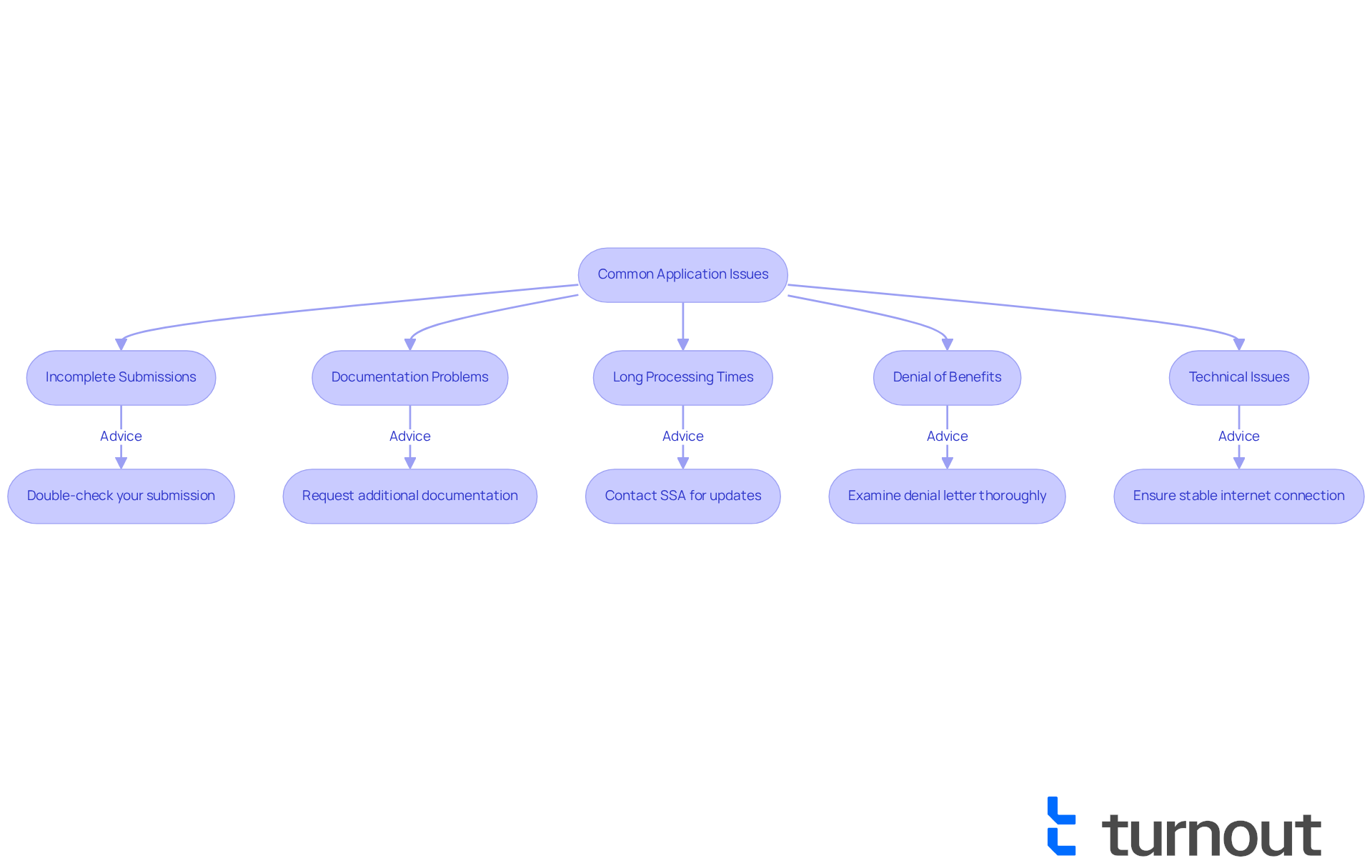
Conclusion
Navigating the complexities of Social Security assistance can feel overwhelming, especially for those seeking financial support due to disabilities. We understand that this journey is not easy, and that’s why this guide is here to provide you with an insightful overview of essential programs like SSDI and SSI. By detailing eligibility criteria, application processes, and necessary documentation, we aim to empower you to approach your claims with confidence and clarity.
Key points discussed include the distinct eligibility requirements for SSDI and SSI. It’s important to note the significance of work history for SSDI applicants and income limitations for SSI recipients. We also emphasize the value of thorough documentation and acknowledge the potential challenges you may face during the application process. By following the outlined steps, you can enhance your chances of a successful application and navigate any obstacles with the right support.
Ultimately, the journey to secure Social Security benefits can be daunting, but remember, assistance is available. Engaging with knowledgeable advocates and utilizing the resources provided can significantly ease the process. Whether you’re gathering documentation or troubleshooting common issues, taking proactive steps today can lead to a more secure financial future for you and your loved ones. You are not alone in this journey, and we’re here to help.
Frequently Asked Questions
What are the main programs of social security assistance?
The two key programs of social security assistance are Disability Insurance (SSDI) and Supplemental Income (SSI). SSDI is for individuals who have contributed to the social insurance system through their work history but cannot work due to a disability. SSI provides financial support to those with limited income and resources, regardless of their employment background.
How is 'disability' defined by the Social Security Administration (SSA)?
The SSA defines 'disability' as a condition that significantly hinders one or more major life activities, which can include both physical and mental health concerns.
What is the average monthly benefit amount for disabled workers receiving SSDI?
As of December 2023, the average monthly benefit for disabled workers receiving SSDI is $1,537.13.
How many individuals receive SSI, and what adjustment will they see in 2025?
Nearly 7.5 million SSI recipients will see their payments adjusted by 2.5% due to a cost-of-living adjustment (COLA) starting in January 2025.
What are the eligibility requirements for SSDI?
To qualify for SSDI, applicants must have a sufficient work history, specifically 40 work credits with at least 20 earned in the last decade, and must have a qualifying disability that prevents them from engaging in substantial gainful activity.
What are the eligibility criteria for SSI?
To qualify for SSI, individuals must be aged 65 or older, blind, or disabled, and have limited income and resources. The maximum monthly SSI payment for 2025 is approximately $967 for individuals and $1,450 for couples, with resource limits of $2,000 for individuals and $3,000 for couples.
Are there special considerations for veterans regarding social security assistance?
Yes, veterans may qualify for government assistance benefits due to service-related disabilities, and there may be additional criteria that apply to them.
How can Turnout assist individuals with SSD claims?
Turnout employs trained nonlawyer advocates to assist clients with SSD claims, ensuring they receive the guidance needed without the complexities of legal representation. However, Turnout is not a law firm and does not provide legal advice.
What should individuals do if they experience significant life changes?
Individuals should report any significant life changes, such as marriage or divorce, as these can influence eligibility for social security assistance benefits.




